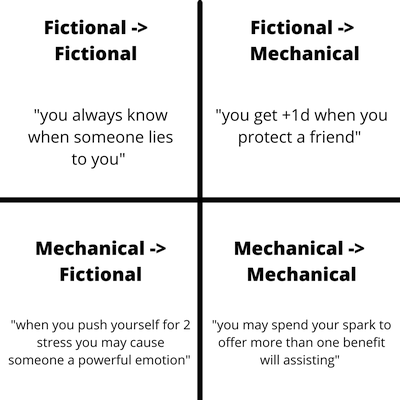Forum:
Ben Roswell of Small Planet Games has put together this breakdown of mechanical effects across four classes of PbtA Move.
The general idea is that a well-designed character class should have moves that cover all four of these quadrants:

Ben Roswell of Small Planet Games has put together this breakdown of mechanical effects across four classes of PbtA Move.
The general idea is that a well-designed character class should have moves that cover all four of these quadrants:

It's not obvious
DeReel - Mon, 01/18/2021 - 06:08... why *completing* the typology is better. Dice -> * and specially, Dice -> Dice does not seem very engaging to me. Is a game better when it is usable with more playstyles ? not necessarily, I mean it's really case by case. Opening to more playstyles means a wider audience and a bigger market. But for that kind of project, Dice and Clouds is an insufficient analysis tool.
PbtA moves are *complex* because there's a lot of different game resources involved, be they mechanical explicit or implicit. By implicit resources I mean things like : field control vs firepower vs intelligence. All these are fictional and I picked military fictional resources to kill in advance the "if it's fictional it's some kind of soft hippy fluff" sort of argument. The typology would benefit from more depth, wrt mechanical resources as in https://caput-caprae.blogspot.com/2020/12/taxonomy-of-powered-by-apocaly... and not less important, fictional resources.
Of course, I'm splitting hair. This typology of moves, however incomplete for designing a whole game, is still a nice tool for GMs wanting to hack a playbook. It's one good way of making sure they re-read their creation with System in mind.
I'm with DeReel
Paul T. - Fri, 01/22/2021 - 10:07It's a pretty basic typology, right? Even Apocalypse World's moves often break out of these molds (like the infamous Hypnotic move), particularly when harm is involved.
But what is the argument for needing to include all four within a playbook? It's not obvious to me.
Consideration
Tod - Fri, 01/22/2021 - 22:17I agree that not all playbooks may require moves from all four quadrants.
But I also believe the designer should consider all four quadrants when creating the character class.
Exactly
DeReel - Sun, 01/24/2021 - 01:28I write and design like I am working a puff paste : adding, checking the fundamentals, adding again, etc. (until I consider part of the paste formed enough and put it on the side to try and "knot it up").
A good reading grid doesn't need to be scientifically true, but stable and simple enough that it can shed a new light on something you've become familiar with.